Improving the Moisture-Induced Part Qualities by Optimization of Plasticization and Processing Parameters of Injection Molding
Shia-Chung Chen1,2,3, Jibin Jose Mathew1,2,4, Cheng-Chang Hsieh1 and Ching Te Feng*1,2,3
1Department of Mechanical Engineering, Chung Yuan Christian University, Taoyuan 32023, Taiwan
2R&D Center for Smart Manufacturing, Chung Yuan Christian University, Taoyuan 32023, Taiwan
3R&D Center for Semiconductor Carrier, Chung Yuan Christian University, Taoyuan 32023, Taiwan
4Department of Electronics and Computer Maintenance, Union Christian College - Aluva, Mahatma Gandhi University, India
Submission: November 06, 2022; Published: November 15, 2022
*Corresponding author: Ching Te Feng, Department of Mechanical Engineering, R&D Center for Smart Manufacturing AND Semiconductor Carrier, Chung Yuan Christian University, Taiwan
How to cite this article: Shia-Chung C, Jibin Jose M, Cheng-Chang H, Ching Te F. Improving the Moisture-Induced Part Qualities by Optimization of Plasticization and Processing Parameters of Injection Molding. Academ J Polym Sci. 2022; 5(5): 555673. DOI: 10.19080/AJOP.2022.05.555673
Abstract
Silver streak marks, air bubble defects, etc. are some of the undesirable features that are regarded as visual surface defects on injected thermoplastic parts and these defects are typically brought on by moisture, trapped air, etc. Moreover, hygroscopic materials have the natural propensity to absorb moisture from the environment during production, thereafter, the finished product can suffer from a number of quality problems, leading to produce more plastic waste. Therefore, to improve the quality of the final product part, this research study aims to examine the impact of injection speed, mold temperature (MT), and plasticization parameter levels on a moisture-induced optical product part. Consequently, it was found that the product samples (C2: 50mm/sec - injection speed, 95 °C MT and C5: 50mm/sec – injection speed, 115 °C MT) produced by the optimization of the plasticization process are perfect resemble to the product part produced by using the dried raw material. Moreover, the measured transmittance value of those samples (C2: 90.59 %, C5: 91.36 %) was close to the transmittance value of the product part produced using the dried raw material (D1: 91.29%). This endorses the research finding that by using the method of optimization of the plasticization and processing parameters of injection molding the product part quality can be improved and the moisture effect defects can be suppressed.
Keywords: Silver Streak Marks; Air Bubble; Atmospheric Moisture Absorption; Hygroscopic Materials; Plasticization Parameter Optimization; Processing Parameters; Injection Molding; Polycarbonate
Introduction
Silver streak marks, air bubble defects, etc. are some of the undesirable features that are regarded as visual surface defects on injected thermoplastic parts. If they do, it may be quite hard to solve this technological issue, especially if the reason for their occurrence isn’t genuinely understood. Surface defects appear in a variety of forms on injected thermoplastic parts; The defects may be brought on by poor mould design (flashing, burning markings, visible weld lines), improper production circumstances, or improper preparation of the polymer granulate, depending on the factors that led to their formation of flow marks, gate design, and others. According to D.V. Rosato and Marlene G. Rosato [1] surface defects like splay marks, air bubbles and silver streaks are typically brought on by moisture, trapped air, etc. Likewise, hygroscopic materials like polyurethane, acrylonitrile butadiene styrene, polycarbonate, and others have found extensive use in engineering, biomedical, and automotive industries. However, because of these materials’ natural propensity to absorb moisture [2] from the environment during production, the finished product can suffer from a number of quality problems, and leading to the produce more plastic waste.
Research studies were conducted to understand the impact of moisture and to improve the product part quality. Thereby, Martin Kusy and Miroslav Kosik [3] in their study, examined the surface defect brought on by moisture and the appearance of silver streaks on the surface of an injection-molded component. Similarly, U. Schulz and S. Jakobs [4] studied how polycarbonate optical lenses are affected by moisture absorption. Moreover, F. Xie and V. Kurusingal [5] in their paper discussed the effect of moisture absorption, surface defects, degradation and stabilization of polyurethane elastomers. Furthermore, H Park and B Kim [6] used the screw quenching experiment in the plasticization process to investigate the formation of entrapped air bubbles in the screw channel. Thereby, Han Su [7] study on the enhancement of moisture-induced plastics injection molding process by plasticization parameters. Likewise, C. T. Feng and others [8] Investigated the method to reduce the effect of moisture on the molded product part by improving the processing parameter levels.
They assert that the plasticization variables of screw rotation, back pressure, and barrel temperature have a significant impact on appearance qualities and that higher screw rotation and melt temperature generate more bubble formation because the melt is less viscous. Thereafter, Tzu Jeng Hsu and others [9] improved the surface quality and eliminated moisture-induced defects like silver streak marks from the product part using the Gas Counter Pressure (GCP) and plasticizing optimization process. They discovered that the surface quality improved in direct proportion to the GCP pressure’s ability to inhibit the formation of silver streaks. Besides, R.S. Chen and C.Y. Yu [10] adapted Taguchi’s approach to eliminate the appearance of silver streak marks from the surface of an injection molded polycarbonate bumper. Thus it seems that all these recent research studies are based on the plasticization process. However, these studies did not determine the effect of the moisture on various injection speeds, mold temperatures, on an optical product part. Therefore, the objective of this research study is to find out the influence of injection speed, mold temperature and plasticization parameter levels on a moisture-induced optical product part and thereby find out an optimised plasticization parameter levels and processing parameter to improve the final product part quality.
Materials and Methods
The purpose of this research study is to analyze the impact of moisture on an optical product part by varying the plasticization parameter levels and thereby to find out the optimized plasticization levels and processing parameters to improve the product part quality. Therefore, this experimental study is divided into two parts.
The first part of the experiment aims to verify the effect of moisture on an optical product part and to determine the optimal parameter levels to improve the final product part quality. Furthermore, these studies also verify the effect of moisture on the product part thickness and melt front area. Therefore, the experimental analysis is carried out in an optical product part injection mold with a 2 mm product part thickness using polycarbonate material (PC). The transparent product part produced by PC material will benefit in visually assessing the impact of moisture content, on the development of product part surface defects such as silver streak, burn mark, and variation in air bubble generation within the product part. Moreover, a three-level design of experiment consisting of 27 combination run is utilized to study the impact of moisture and to find out the optimized plasticization parameter to improve the product part quality. Consequently, the second part aims to verify the effect of moisture on the optical product part with different injection speed and mold temperature, and to investigate the influence of injection speed and mold temperature on the optical product part quality improvement. Three different injection speed and two mold temperature values are chosen to run the experimental run effect analysis on the optical product part. Thereafter, the quality of the optimized product part sample is evaluated by measuring the transmittance value and by visual observation. Thereafter the obtained transmittance value is compared with the optical product part sample produced by using the properly dried raw material.
The experiment run is carried out on the FCS HT-150 SV injection molding machine and by using the hygroscopic polycarbonate material. Polycarbonate material - PC 110 produced by CHIMEI corporation with a moisture content of 800 ppm is used to conduct the experiment. Mettler Toledo’s moisture analyzer HC103 was used to determine the moisture content of the material in accordance with ASTM D570, the standard test method for plastic water absorption.
In this research study, a full spectrum transmittance measurement method is adapted to assess the product part quality, in which the transmittance value of the product part sample was measured by using a full spectrum transmittance measuring equipment. A full spectrum transmittance measuring equipment (Figure 1) is a measuring instrument that is used to measure the wavelength of an electromagnetic radiation and normally a spectrometer is used to analyze the difference that take place on the transmittance, reflection and absorption property of the electromagnetic radiation after it pass through a sample part (Figure 2). Thereby the characteristic of the sample part is analyzed with varied range of incident wavelength. This full spectrum transmittance measuring equipment is developed by Dongfang solar, Taipei –Taiwan. The product offers a spectral deviation of ± 0.1 nm and used to visualize and analyze the wavelength ranges from 380nm -780 nm. Furthermore, more than 920 measured test data are provided from each of the sample part. Thereby the difference in the percentage of the interacted transmittance spectrum is used to analyze the product part sample quality and ASTME 275-93 transmittance measuring standard is used to measure the part sample transmittance. As a result, the impact of moisture on the 2 mm product part is evaluated visually and from the transmittance value of the product part samples; the product part geometry is shown in Figure 2. The measurement area is close to the front of the gate, in the middle of the widefaced and from the surface defect portion.
Results
First part: Optimization of plasticization parameter
The raw plastic material with moisture content of 800 ppm is used to run the experiment study with three different levels of the plasticization parameters. Table 1 shows the plasticization factors with their levels. The rest of the machine parameters are kept fixed to produce a product part without short shot defect and Table 2 shows the machine parameter settings. The experiment will be run in all combinations to study the impact of moisture with the different levels of plasticization parameters variables, screw rotation, barrel temperature, and back pressure (Table 1) and thus to find out the optimized parameter level values to reduce moisture defects, the Taguchi method is adapted to build the experimental DOE and Table 3 shows the experimental run DOE. Due to the change in plasticization combination, surface defects such as silver streak, air bubbles, and so on were discovered in the final product part due to the presence of moisture. Therefore, the product part samples are taken after the machine obtain consistency thereby the optimised plasticization factor level to reduce the impact of moisture on the product part is find out and the quality of the optimized product part sample is evaluated by measuring the transmittance value and by visual observation. Thereafter the obtained transmittance value is compared with the optical product part sample produced by using the properly dried raw material.
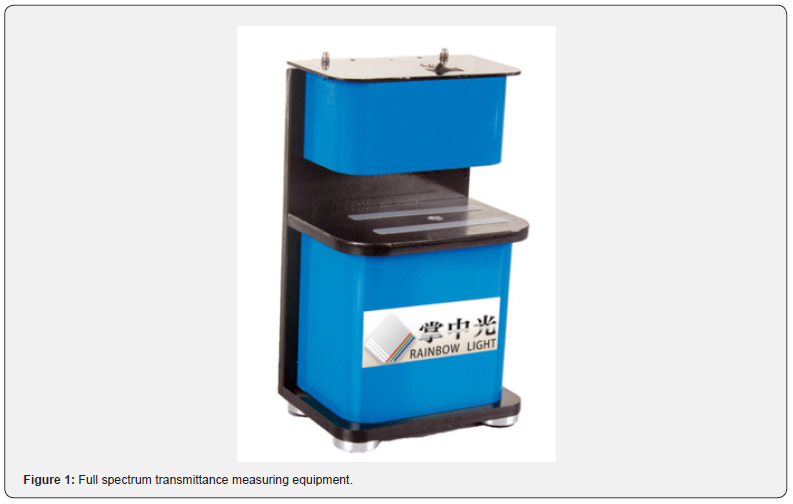
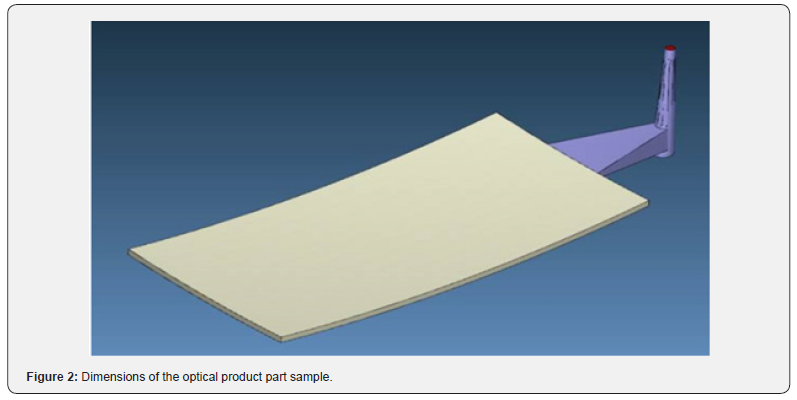


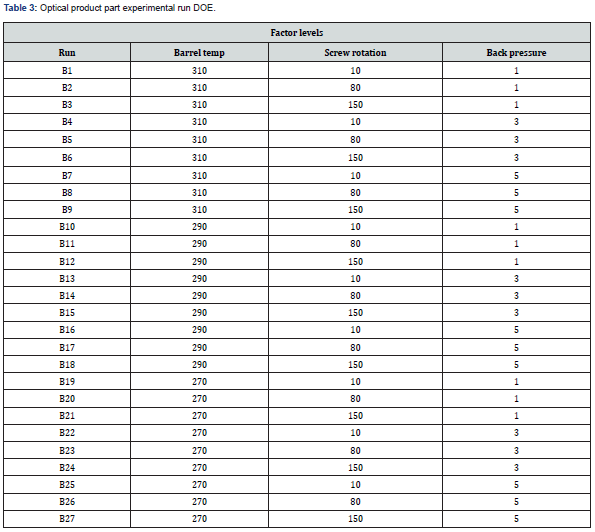
Second part: Effect analysis of moisture with different injection speed and injection mold temperature
The experiment run is conducted with the machine parameter and optimized plasticization parameter values obtained from the first part experiment analysis “Section 4.1.1” , undried Polycarbonate material PC 110 of 800 ppm is used to evaluate the effect of moisture. Three different injection speed (20 mm/sec, 50 mm/sec, and 90 mm/sec) and two mold temperature values (95 °C and 115 °C) are chosen to run the experimental run effect analysis on the optical product part. To evaluate the influence of the moisture content on the injection speed and injection mold temperature the experiment run is repeated several types to obtain consistency and the samples are taken for each combination run. Table 4 shows the machine parameter setting and Table 5 shows the design of experiment. Product part samples are taken after the machine obtains consistency and the quality of the optimized product part sample is evaluated by measuring the transmittance value and by visual observation. Thereafter, the obtained transmittance value is compared with the optical product part sample produced by using the properly dried raw material.


Discussion
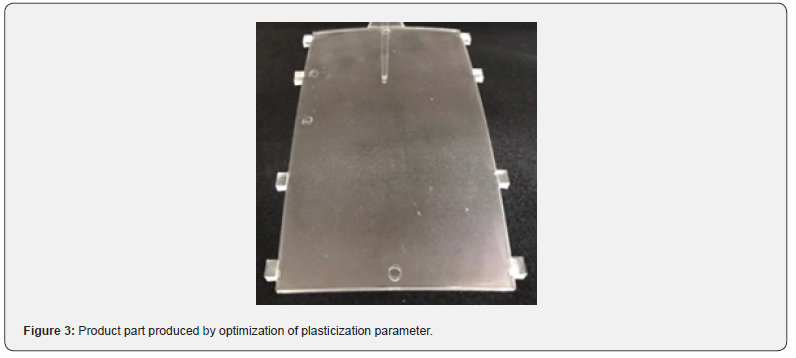
The product part samples are taken from each experimental combination run (Table 3), and the appearance of the air bubble defect and silver streak marks on the product part surface is observed to vary with the experimental run parameter settings on the product part samples, indicating that the effect of the moisture content has an influence on the parameter settings.
First part: Optimization of plasticization parameter
Product part produced by optimization of plasticization parameter:
Figure 3 depicts the image of the ideal optical sample part obtained through plasticization parameter optimization. Ideal product part samples (Figure 3) are produced by the B25 experimental run plasticization parameter levels that is at the barrel temperature of 270 °C, screw rotation of 10 rpm and at a back pressure level set to 5 bar. All of these plasticization parameter levels represent and validate the research finding that the impact of moisture and its associated defects can be reduced and bypassed by lowering the plasticization parameter barrel temperature and screw rotational speed and elevating the back pressure to a high level.
Product part produced under different screw rotation speed:
Figure 4 shows the product part images produced under different screw rotation speed set to 10 rpm, 80 rpm and 150 rpm while the rest of the parameters such as the barrel temperature, back pressure and injection speed are kept fixed (270 °C, 5 bar, 50mm/sec). It can been seen that the least or absence of moisture defects are found with the lowest screw rotational speed such us on the B25 (270 °C, 5 bar, 10 rpm) experimental run parameter setting while for the B26 (270 °C, 5 bar, 80 rpm) and B27 (270 °C, 5 bar, 150 rpm) parameter settings it can be seen that the moisture impact silver streak mark defect is most likely visible on the product part surface, and a small number of air bubble defects (one to two) are likely to appear at a higher screw rotation speed; this phenomenon may have occurred due to the decrease in the new optical product part thickness, causing the vaporized water vaper to migrate to the surface part and appear in the form of splay mark defect. Furthermore, at an 80-rpm screw rotational speed, the distribution of the splay mark is more likely found on the top middle portion, but as the screw rotational speed increases to 150 rpm, the silver streak mark defect is more widely spread out from the gate position of the product part sample to the lower end position. As a result, from the experimental run observation it endorses the research finding that the screw rotation speed can be lowered to a lower level to improve the product part quality and to eliminate the air bubble defect caused by the presence of moisture.
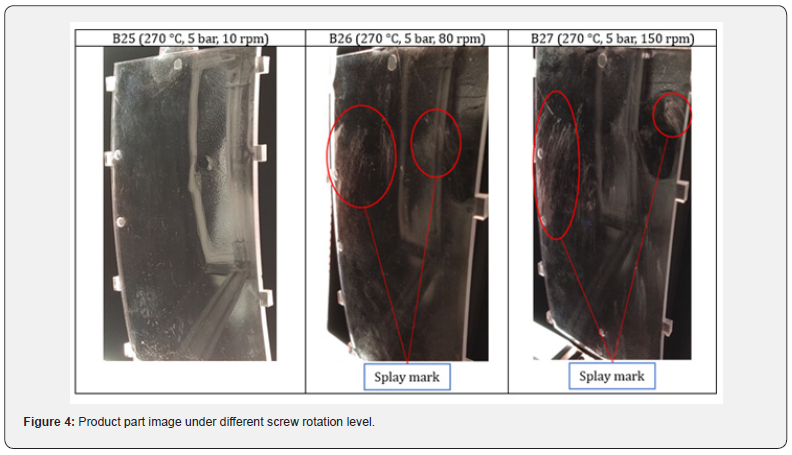
Figure 5 shows the product part images produced under different back pressure levels of 1 bar, 3 bar and 5 bar and these product parts are produced from the B19 (270 °C, 1 bar, 10 rpm), B22 (270 °C, 3 bar, 10 rpm) and B25 (270 °C, 5 bar, 10 rpm) experimental run experimental run parameter setting. Here it seems that setting the barrel temperature and screw rotational speed to a lower level appears to produce the least number of defective product parts, and as per the obtained product part samples, moisture impact silver streak mark defects are more visible at a lower back pressure level of 1 bar and appear to spread across the top of the product part surface. Furthermore, it appears that with the increase in the back-pressure value tends to produce more stable product parts with improved product part quality and seems to have a significant effect on controlling defects caused by the presence of moisture. As a result, the experimental observations show that the plasticization parameters such as screw speed, barrel temperature, and back pressure can be set to this optimized plasticization parameter level setting B25 (270 °C, 5 bar, 10 rpm) in order to reduce the effect of moisture and to improve product part quality of the given optical product part.
Second part: Effect analysis of moisture with different injection speed and injection mold temperature
Experiment analysis with different Injection speed and at 95 °C mold temperature:
Figure 6 shows the product part images produced with different injection speed and at a mold temperature of 95 °C. C1-Figure 6, shows the optical product part image produced at an injection speed of 20 mm/sec from the image it is observable that few moisture effect defect are produced at the top at bottom portion of the product part. However, with the increase in injection speed to a higher level of 90mm/sec (C3 - Figure 6) it is noticeable that silver streak mark defects started to appear and widely spread over the product part and more visible on the top portion from gate location. On the other hand, when the injection speed is set to 50 mm/sec, the product part surface has the least or no moisture effect defects (C2 - Figure 6), so we can adapt the 50 mm/sec injection speed to produce the ideal product part at 95 °C and the measured transmittance value of the optimized sample part at 95 °C mold temperature is 90.59%.
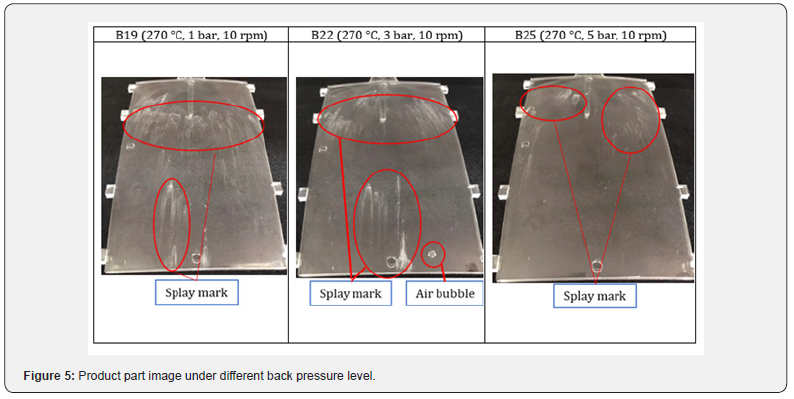
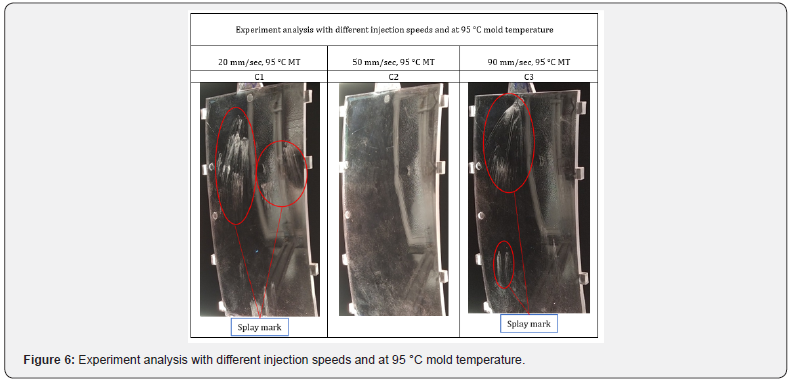
Experiment analysis with different Injection speed and at 115 °C mold temperature:
Figure 7 shows the product part images with different injection speed at a mold temperature of 115 °C. From the product part images (Figure 7, C4, C5 & C6) it is noticeable that the appearance of silver streaks and air bubble defect brings with various injection speed and it seems that through the increase in mold temperature to 115 °C and setting the injection speed to 90 mm/sec produce the silver streak, air bubble defect in a large portion(C4 - Figure 7). However, it seems to bring an ideal product part at 50 mm/sec injection speed (C5 - Figure 7) and the measured transmittance value of the optimized sample part at 115 °C mold temperature is 91.36%. Furthermore, there are also various reasons that might leads to the appearance of the silver streak marks on the product part surface such as the material is filled with gas; mixed with dissimilar materials or incompatible melts; the runner and gate are small; the melt flows from the thin wall of the product into the thick wall; discharge air; high mold temperature; there is moisture on the surface of the mold cavity, too much lubricating oil or mold release agent or improper measurement of mold release agent; low mold temperature, low injection pressure, and low injection speed; plastic melt temperature is too high; moreover, when the injection pressure is small, the needle-like streaks with silvery white luster appear on the surface of the product along the flow direction of the melt, which is called silver streaks. As a result, it is difficult to comprehend and endorse that the occurrence of these surface defects is caused by the effect of moisture on injection speed. Moreover, sink mark defect also seems to appear on the product part samples with the increase in the mold temperature and these defects can be removed with the increase in packing pressure.
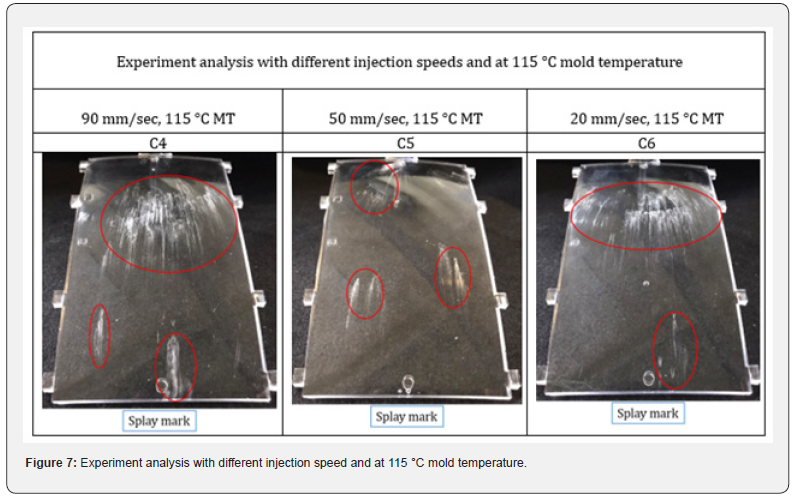
Comparison of the optimized product sample with transmittance value
Figure 8 shows the optimized product part images obtained at different mold temperature (95 °C and 115 °C). From the product samples (C2 and C5) produced by the optimization of the plasticization process it is observable that the product samples are exactly perfect resembles to the product part produced by using the dried raw material. Moreover, the measured transmittance value of those samples (C2: 90.59 %, C5: 91.36 %) was close to the transmittance value of the product part produced using the dried raw material (D1: 91.29%). This endorses the research finding that by using the method of optimization of the plasticization parameters such as screw rotation, back pressure, and barrel temperature the product part quality can be improved, and the moisture effect defects can be suppressed.
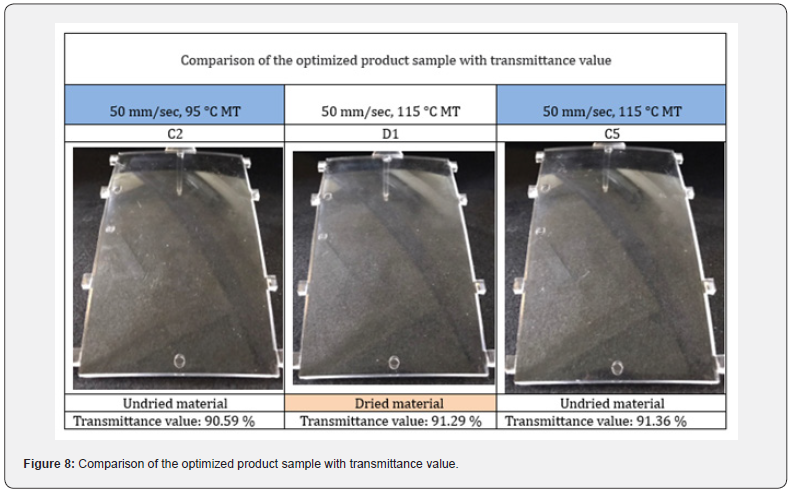
Conclusion
From the experiment analysis it seems that the appearance of silver streaks and air bubble defect brings with various injection speeds and it shows through the increase in mold temperature to 115 °C and setting the injection speed to 90 mm/sec produce the silver streak, air bubble defect in a large portion. Though, it seems to bring an ideal product part at 50 mm/sec injection speed. Thereby, an ideal product part samples are produced for the optical product part at the barrel temperature of 270 °C, screw rotation of 10 rpm and at a back pressure level set to 5 bar experimental run plasticization parameter levels. Moreover, the transmittance value (90.59 %) of the product part produced by the optimized plasticization parameter was close to the transmittance value of the dried sample (D1: 91.29%), and their transmittance value difference is less than 1%. However, there are also various other reasons that might leads to the appearance of the silver marks on the product part surface such as the material is filled with gas; mixed with dissimilar materials or incompatible melts; the runner and gate are small; the melt flows from the thin wall of the product into the thick wall; discharge air; high mold temperature; there is moisture on the surface of the mold cavity, etc. As a result, it is difficult to comprehend and endorse that the occurrence of these surface defects is caused by the effect of moisture on injection speed and mold temperature. Conversely, the product samples (C2: 50mm/sec – injection speed, 95 °C MT and C5: 50mm/sec – injection speed, 115 °C MT) produced by the optimization of the plasticization process are perfect resembles to the product part produced by using the dried raw material. Moreover, the measured transmittance value of those samples (C2: 90.59 %, C5: 91.36 %) was close to the transmittance value of the product part produced using the dried raw material (D1: 91.29%). This endorses the research finding that by using the method of optimization of the plasticization parameters such as screw rotation, back pressure and barrel temperature the product part quality can be improved and the moisture effect defects can be suppressed.
References
- Rosato DV, Rosato MG (2012) Molding variable & property responses-Appearance properties. In Injection Molding Handbook; Springer: New York, NY, USA, pp. 599.
- Stan DV (2020) Considerations on the Drying of the Raw Material and Consequences on the Quality of the Injected Products. Mater Plast 57(1): 46-56.
- Bilik J, Naplava A, Kusy M, Kosik M, Likavcan L (2014) Silver Streaks on Surface of Injected Thermoplastic Parts. Res Pap Fac Mater Sci Technol Slovak Univ Technol 22(34): 21-27.
- Schulz U, Jakobs S, Anton B, Kaiser N (1953) Formation of surface defects on polymer lenses depending on moisture absorption. Anal Bioanal Chem 353: 740-742.
- Xie F, Zhang T, Bryant P, Kurusingal V, Colwell JM, et al. (2019) Degradation and stabilization of polyurethane elastomers. Prog Polym Sci 90: 211-268.
- Park H, Kim B, Gim J, Han E, Rhee B (2017) A Study on the Entrapped Air Bubble in the Plasticizing Process. In Proceedings of the Annual Technical Conference-ANTEC, Conference Proceedings, Anaheim, CA, USA, p. 8-10.
- Su H (2021) Study on the Improvement of Moistured Plastics Injection Molding by Plasticization Parameters. CYCU Master’s thesis.
- Chen SC, Su H, Mathew JJ, Gunawan H, Hwang CW, et al. (2022) An Investigation to Reduce the Effect of Moisture on Injection-Molded Parts through Optimization of Plasticization Parameters. Applied Sciences 12(3): p. 1410.
- Chen SC, Su H, Hsu TJ, Feng CT, Shen EN, et al. (2022) Surface Improvements on Silver Streak Marks of Injection Molded Moisture Plastics Using Gas Counter Pressure and Plasticizing Optimization. In Materials Science Forum 1064: 39-45.
- Chen RS, Lee HH, Yu CY (1997) Application of Taguchi's method on the optimal process design of an injection molded PC/PBT automobile bumper. Composite Structures 39(3-4): 209-214.






























